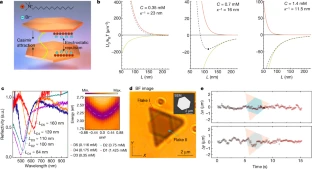Science Daily December 2, 2021
Self-ordering in molecular and biological systems typically involves short-range hydrophobic and van der Waals interactions. An international team of researchers (Sweden, Russia) has found a way process for micrometre-scale self-assembly based on the joint action of attractive Casimir and repulsive electrostatic forces arising between charged metallic nanoflakes in an aqueous solution. This system forms a self-assembled optical Fabry–Pérot microcavity with a fundamental mode in the visible range (long-range separation distance about 100–200 nanometres) and a tunable equilibrium configuration. By placing an excitonic material in the microcavity region, they were able to realize hybrid light–matter states whose properties, such as coupling strength and eigenstate composition, could be controlled in real time by the concentration of ligand molecules in the solution and light pressure. These Casimir microcavities could find future use as sensitive and tunable platforms for a variety of applications, including opto-mechanics, nanomachinery and cavity-induced polaritonic chemistry…read more. TECHNICAL ARTICLE

The self-assembled microcavity system and the physical mechanism behind its operation. Credit: Nature volume 597, pages214–219 (2021)